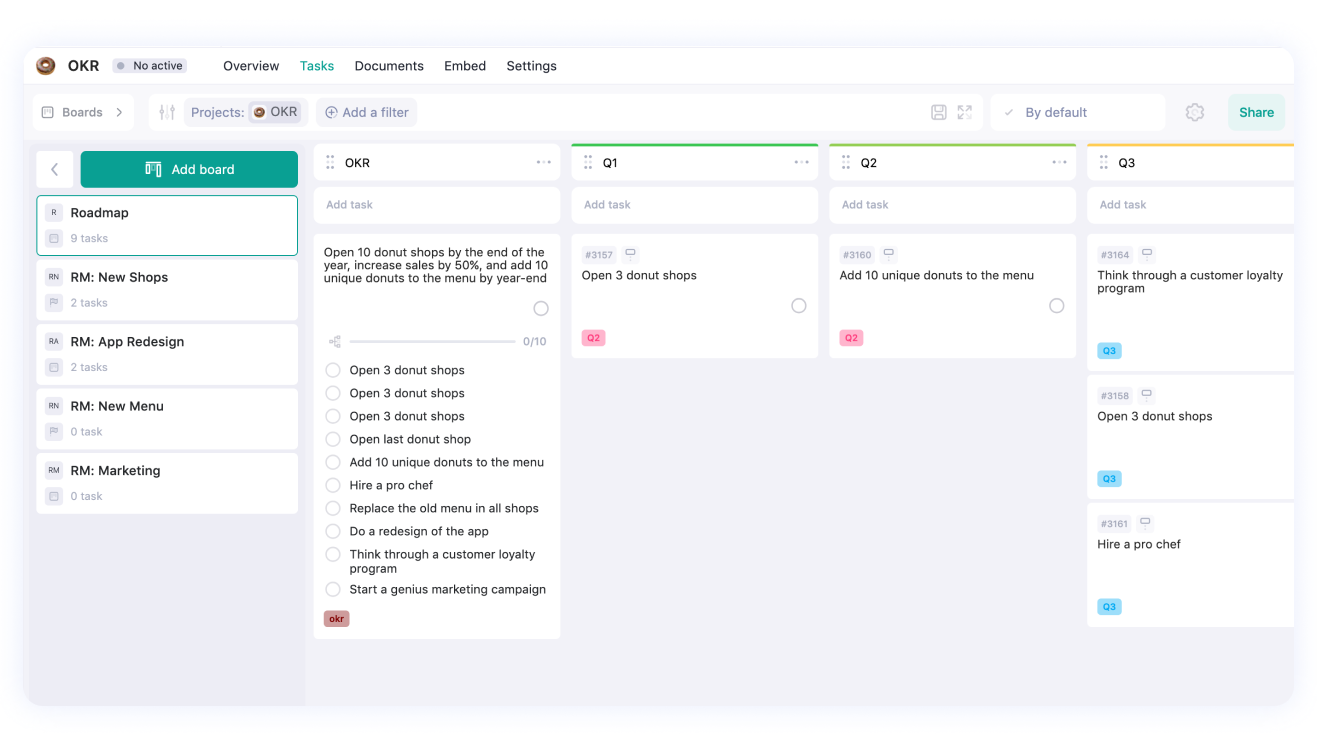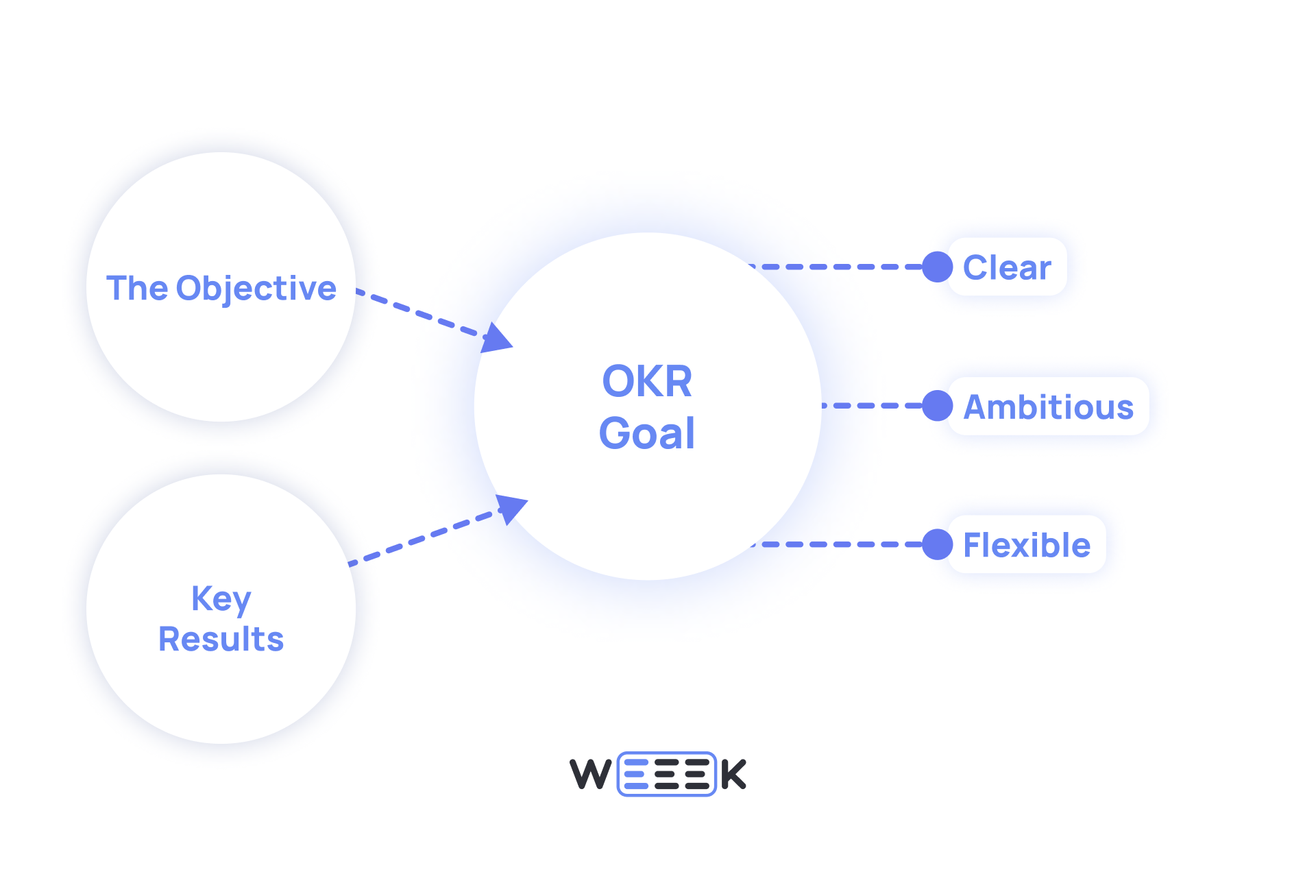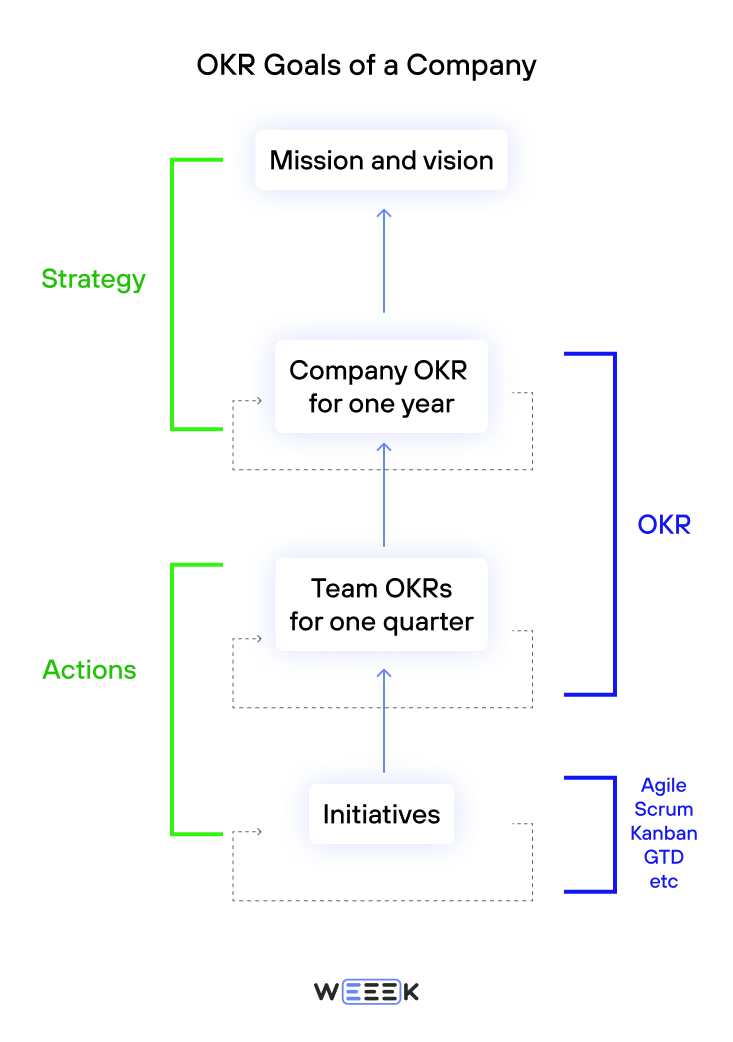What are OKRs?
📌 OKR, or Objectives and Key Results, is a framework that companies use to define and align clear, high-impact goals.
OKRs originated in large corporations, where there was a need to unify vast teams around strategic objectives and synchronize efforts across diverse departments.
Today, the versatility and effectiveness of OKRs make them adaptable for companies of any size, from startups to major corporations.
An OKR goal is crafted to be easily understood by everyone on the team, from top executives to interns just joining the company.

The History of OKR Methodology
OKRs date back to the 1970s when Intel’s CEO, Andy Grove, implemented a goal-setting system aimed at transparency and directing employee efforts toward the company’s main strategy.
Intel’s goal at that time was straightforward: “To capture the leading position in the next-generation microprocessor market.”
This objective was supported by key results such as launching a processor with 20% higher performance than competitors, achieving a 40% market share in the new processor segment within six months of release, and more.
Grove also established guiding principles for the framework:
- Every team member understands the company’s goals.
- Limit goals to 3–5 per OKR cycle.
- Goals are set both top-down and bottom-up.
- Goals should adjust to changing conditions.
- Goals should be highly challenging.
- Leaders don’t impose goals on team members.
- OKRs are for achieving objectives, not for team evaluation.
In the 1990s and early 2000s, OKRs spread through Silicon Valley and became part of Google’s corporate culture, with John Doerr, author of a seminal book on OKRs, as a key advocate of the method.
Examples of Successful OKR Implementation
Let’s explore how industry giants have effectively leveraged OKRs.
Google has used OKRs for over 20 years and has been instrumental in advancing the methodology. OKRs are considered a key factor in Google’s success.
Through OKRs, Google has launched iconic products like Google Search, Android, and Chrome, and expanded its services with the Google Cloud Platform.
For example, one of Google’s OKR goals was to make Google Chrome the best browser in the world.
While this is a broad objective, it becomes actionable with specific key results: increasing Chrome’s market share to 60%, reducing average page load time by 20%, gaining 100 million new active users, and achieving a 95% positive user feedback score for Chrome.
Intel
Intel is another leading example of OKR adoption, using OKRs to stay at the cutting edge of semiconductor innovation.
The company consistently sets OKRs targeting key metrics like chip performance, energy efficiency, transistor count, and product development speed.
One recent OKR goal for Intel was to improve customer loyalty by 2024.
Initially broad, this goal is clarified through key results: increasing the Net Promoter Score (NPS) by 10%, reducing customer complaints by 20%, halving the time to resolve issues, and increasing positive product reviews by 15%.
Examples of OKRs Across Different Fields
Let’s bring OKRs down to real-world applications. This flexible framework is perfect even for startups and small companies. Here are some examples:
Sales Department OKR
- Objective: Increase the conversion of leads to paying customers
- Key Results: Achieve a 20% increase in lead-to-customer conversions within six months; raise the average deal size by 15% within the same period
Content Marketing OKR
- Objective: Boost the website’s SEO rankings
- Key Results: Improve the website's SEO score from 75 to 93 (according to SEO tools); acquire 30 referral links from external sites; double blog output from 10 to 20 articles per month
Product Management OKR
- Objective: Build awareness for an upcoming product launch
- Key Results: Gain four new partner sponsors, craft a compelling press release, and distribute product samples and brochures to 20 leading social influencers
Startup OKR
- Objective: Improve efficiency and cut operating costs
- Key Results: Increase productivity by X% through process improvements and waste reduction; decrease operating expenses by Y% through optimized methods; enhance product quality by Z% with ongoing employee training

📌 Manage your OKRs seamlessly with WEEEK!
Core Principles of OKRs
OKRs are unique among goal-setting frameworks, distinguished by three key traits:
- 1. Flexibility in the tools and methods used to achieve goals
- 2. Universality, ensuring goals are relevant and understood across the entire company
- 3. Ambition, with OKRs encouraging highly challenging objectives

This methodology emerged from industry giants like Google, Intel, Dropbox, Twitter, and Samsung—companies where top management must set ambitious targets while keeping numerous employees engaged and motivated by clear goals.
The framework is built on two primary components.
Objectives
The overarching goal or direction to grow, improve, or achieve. In OKRs, an objective represents a broad, easily understood aim, not limited to one department.
For example, an objective might be to boost customer loyalty at our pizzeria, a goal everyone can relate to—from sales teams and app developers to delivery staff.
Key Results
Measurable outcomes that track progress toward the objective.For instance, refining the customer loyalty objective could mean achieving an average customer rating of 4.6/5. This concrete metric makes the goal actionable.
☝️ A single OKR goal can include multiple key results. In our pizzeria example, key results could involve reaching a 40% customer return rate and an average check size of approximately 50 dollars, clarifying success for the whole team.
Key Differences Between OKRs, SMART, and KPI
One distinctive feature of OKRs is their ambitious nature; goals are set so high that reaching 60–70% completion is often considered a success. Achieving 100% of an OKR goal suggests the goal wasn’t ambitious enough!
SMART Method
SMART goals are crafted to be:
- S – Specific
- M – Measurable
- A – Achievable
- R – Relevant
- T – Time-bound
The SMART framework is ideal for personal productivity goals, like learning a new skill, losing weight, or improving language proficiency. It’s also effective for team projects, departmental tasks, or specific campaigns, where a single clear, attainable goal is beneficial. SMART is particularly useful for delegating specific tasks, making expectations easy to follow.
And here's the main difference 👇
While SMART goals are realistic and concrete, making them perfect for completion-focused objectives, OKRs are designed to be ambitious—even aspirational—and often lack a fixed deadline. SMART goals emphasize attainability and time-bounded results, whereas OKRs aim to push limits without strict time constraints.

KPI: A Different Approach
KPIs, or Key Performance Indicators, are linked directly to routine tasks and formal job responsibilities, with targets typically embedded in job contracts as month-by-month expectations. This makes KPIs less about aspiration and more about meeting expected benchmarks.
❗ OKRs, in contrast, are not well-suited for financial incentives.

When OKR targets are tied to bonuses, employee focus tends to narrow to operational tasks aimed at hitting metrics, which can stifle innovation and ambition. Furthermore, if an OKR goal isn’t fully achieved—which is often by design—bonuses tied to such goals might be missed, potentially dampening morale.
Working with OKRs, however, allows employees to innovate and take calculated risks in achieving objectives, understanding that missing 100% is part of the process. KPIs, on the other hand, require strict adherence to set goals with little room for improvisation, ensuring tasks are completed as planned to meet specific, attainable targets.
How to Set OKR Goals: 8 Steps for Companies
First, two key points:
☝️ There is no one-size-fits-all OKR implementation process that works for every company
☝️ Avoid adopting OKRs just because companies like Google did so
OKRs may not be a fit for every business. This framework is intended to solve specific, real challenges. Implementing OKRs simply for the sake of it won’t deliver results.
❓ So, what kind of issues can OKRs help address? They’re useful when processes need a refresh—such as when the company has grown and old methods aren’t effective—or when it’s essential to re-engage employees and motivate them toward new goals.
OKRs allow room for experimentation. Test the framework across the company or try it with a few departments to see what best suits your needs.
Here are the steps to implement OKRs:
Step 1. Define the Objective
Start with a broad, ambitious goal, without specific metrics. Examples:
- Improve customer loyalty
- Become the world’s best donut company
- Ensure our product is in every household
These goals are ambitious yet broad, and will become actionable with key metrics.
Step 2. Add Key Results
Key Results are measurable metrics, typically numerical, that indicate progress toward the objective.
- Achieve a 50% customer return rate
- Open 10 new donut shops
- Sell 500,000 units of the product
Step 3. Communicate the Goals to Employees
Host a company-wide meeting to share the overarching objective.
You don’t need to label it as an OKR goal; simply say, “Our aim is to become the best donut chain in town!” 🎯
Then share the specific targets: “To make this happen, we need to open 10 new shops, increase sales by 50%, and add 10 new menu items with various fillings and glazes.” 📈
💡 Ensure the goal is easily accessible for quick reference. You might post it on a prominent office board or in the company’s task management system. For instance, in our WEEEK platform, you can create a Knowledge Base entry or a task thread where employees can offer feedback.

Step 4. Appoint Internal Ambassadors
Identify and train team members who will guide the team’s progress toward OKRs and keep the goals top of mind.
Project managers or team leads can take on this role, helping to refine processes, provide feedback on employee initiatives, and support experimentation within teams.
These ambassadors should have sufficient time and resources to manage the team and monitor task statuses effectively.
Step 5. Roll Out OKRs Gradually
Start with a few teams or a single department rather than launching OKRs company-wide.
This approach serves two main purposes:
- It allows for a controlled, gradual transition in case OKRs need adjustments
- It enables fine-tuning of the OKR framework in real-world conditions, refining workflows, communication, and reporting processes
If the initial phase succeeds, more teams can be gradually brought on board.
Step 6. Set Up a Feedback Loop
Establish a consistent feedback mechanism, such as regular meetings. Without feedback, it’s difficult for an experimental framework like OKRs to evolve.
❗ For OKRs to work, there needs to be a two-way exchange: leadership sets challenges and broad objectives, while teams suggest the best ways to achieve results and evaluate metrics. Real-time feedback from team members is crucial.
Step 7. Foster Initiative
OKRs encourage a hands-off approach, allowing employees the freedom to take initiative, test ideas, and structure their work independently.
Empower employees to experiment, test hypotheses, try new approaches, cross-collaborate, and pursue training opportunities. Implementing OKRs may require significant investment, but it’s a worthwhile commitment.
Step 8. Monitor Key Metrics
Regularly track metrics to assess OKR progress.
Review monthly metrics, evaluate quarterly outcomes, and ultimately assess annual results to ensure objectives are being met at impactful levels.
Tips for Effective OKR Implementation
Set Multiple Goals
Experts recommend aiming for 3–5 OKR goals, but no more than 10. Too many goals can lead employees to pick and focus only on those they connect with most, diluting overall team alignment.
Make Goals Visible
Post OKRs in a prominent place—on a corkboard in the office or within a shared digital workspace—so they stay top of mind for everyone.
Gather Frequent Feedback
It’s essential that goals inspire and motivate while remaining achievable. Regular feedback helps ensure that OKRs are relevant and within reach.
Stay Flexible
Be prepared to adjust or even abandon goals if they become obstacles. OKRs are designed to be a flexible framework that adapts to evolving needs.
Integrating OKRs with Scrum and Kanban
Since OKRs are a goal-setting framework, they integrate well with other methodologies that focus on managing work processes, like Scrum and Kanban.
OKR and Scrum
✔️ OKRs and Scrum are a great match, with Scrum focusing on short-term sprints (1–4 weeks) and OKRs driving long-term objectives. Scrum’s regular check-ins and iterative approach help teams stay on course toward their OKR goals by breaking down strategic objectives into short-term, actionable tasks.
OKR and Kanban
✔️ Kanban’s visual workflow management pairs well with OKRs, allowing teams to track progress, identify issues, assess metrics, and monitor performance quality.
One practical approach to using Kanban with OKRs is to post the OKR goal on the Kanban board, breaking it down into smaller tasks needed to reach the objective. This way, progress is visible, and the team can move steadily toward OKR completion.

Benefits of Using OKRs
If you’re not yet convinced of OKR’s strengths, here’s our last word on why it works so well—after this, we’re out of arguments!

Consider our pizzeria example with the goal of boosting customer loyalty by achieving an average rating of at least 4.6 out of 5. This goal is clear, specific thanks to its measurable metric, and relevant to everyone.
It’s also ambitious! Every order needs to be nearly perfect—from a seamless online ordering experience and a friendly courier to that soft crust and melty cheese waiting under the lid.
✔️ This highlights OKR’s first key strength: motivating employees to aim for top-tier results.
✔️ The second strength is its ability to align everyone’s efforts within the company.
When employees commit to a shared goal, each contributes within their area of expertise: developers create a smooth user experience, chefs focus on perfecting recipes, and couriers ensure fast, friendly delivery.
✔️ The third strength of OKRs is that they free employees from restrictive processes.
With OKRs, employees work as specialists in their fields, free to improvise, make mistakes, and experiment. Instead of a rigid step-by-step plan, OKRs encourage a series of initiatives.
💡 Of course, some areas—like pizza recipes—require structure (adding pineapples to a meat-lover’s pizza may not go over well!). But other departments, like sales, might experiment with promo codes, while social media managers try new content ideas to engage audiences.
In summary: OKRs enable companies to set ambitious, clear goals that are universally understood, unbound by specific roles, and open to flexible, innovative approaches to achievement.
What to Read on OKRs
- "Objectives and Key Results: Driving Focus, Alignment, and Engagement with OKRs" by Paul Niven and Ben Lamorte. This book is written by OKR ambassadors and coaches. It connects theory with practical steps for implementing OKRs
- "Measure What Matters" by John Doerr. This book by John Doerr, a practitioner who helped introduce OKRs at Google, shares insights from his experience
- "The Beginner's Guide to OKR" by Felipe Castro. This foundational guide explains the core principles of OKRs and is free to download online
Key Takeaways
✔️ OKR is a framework for setting ambitious goals with measurable key results across projects, departments, or companies
✔️ OKRs are designed to push limits, often targeting only 70% completion—if a goal is fully achieved, it may not have been ambitious enough
✔️ This framework is ideal for helping teams and companies stay focused on truly impactful goals. It can drive company growth and boost employee confidence by encouraging bold objectives
✔️ To implement OKRs at the company level, start by defining the objective based on a key metric, appoint ambassadors to champion the goals, and set up regular check-ins to track progress















